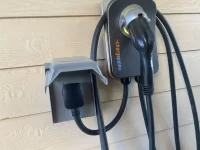After a lot of research, I finally pulled the trigger and got a Grizzl-e Smart. I'll be installing it outside and using a lock to keep it in place (I'm not super worried about theft, but figure better safe than sorry). We're up on top of the hill in the SF peninsula and can get some intense wind/rain/fog, so a really weatherproof unit is essential which the Grizzl-e excels at. Unfortunately, the Chargepoint doesn't have a lock and the Enel-X is very large and won't install cleanly on the outside of our house.
My main hesitance on the Grizzl-e Smart was that it does not have an app usable from the manufacturer, and any open-source software (
SteVe for example) are poorly supported and difficult to maintain. I talked with Grizzl-e and at this point the ChargeLab app is a reliable way to connect the charger and use scheduled charging as well as track usage. [
here's the setup guide]
I should have it set up in a week or so and will test it with a friend's Ioniq 5 (my AGT is still at least a month out). I'll post impressions after we test it.

